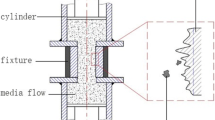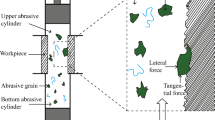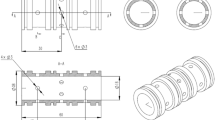Abstract
Abrasive flow precision machining technology is an effective technology for precision machining special-shaped curved surface products in the mechanical field. In order to explore the vortex formation mechanism of special inner curved surface machined by abrasive flow precision machining, taking the polygonal spiral curved surface tube as the research object, the large eddy simulation method is used to analyze the precision machining behavior of abrasive flow and the effect of vortex cluster on the wall under different inlet pressure. The motion law of abrasive is expounded, the formation mechanism of the fluid vortex is revealed, and the mechanism of abrasive micro-cutting is discussed. The results show that the inlet pressure of abrasive flow plays an important role in the machining quality of abrasive flow. With the increase of inlet pressure, the precision machining quality of abrasive flow is improved accordingly. Properly increasing the inlet pressure of the abrasive flow can effectively improve the inner surface machining quality of the polygonal spiral curved surface tube, and the abrasive flow precision machining technology can obtain the ideal surface quality and improve the surface accuracy of the machined workpiece.



















Similar content being viewed by others
References
Sambharia J, Mali HS (2019) Recent developments in abrasive flow finishing process: a review of current research and future prospects. Proc Inst Mech Eng 233(2):388–399. https://doi.org/10.1177/0954405417731466
Petare AC, Jain NK (2018) A critical review of past research and advances in abrasive flow finishing process. Int J Adv Manuf Technol 97(1-4):741–782. https://doi.org/10.1007/s00170-018-1928-7
Li JY, Yang LF, Liu WN, Zhang XC, Sun FU (2014) Experimental research into technology of abrasive flow machining nonlinear tube runner. Adv Mech Eng 6:1283–1287. https://doi.org/10.1155/2014/752353
Wang XC, Wang CC, Wang CY, Sun FH (2018) Approach for polishing diamond coated complicated cutting tool: abrasive flow machining (AFM). Chin J Mech Eng 31(6):154–168. https://doi.org/10.1186/s10033-018-0296-4
He Y, Chen ZT (2014) Optimising tool positioning for achieving multi-point contact based on symmetrical error distribution curve in sculptured surface machining. Int J Adv Manuf Technol 73(5-8):707–714. https://doi.org/10.1007/s00170-014-5862-z
Tadic B, Todorovic PM, Luzanin O, Miljanic D, Jeremic B, Bogdanovic B, Vukelic D (2013) Using specially designed high-stiffness burnishing tool to achieve high-quality surface finish. Int J Adv Manuf Technol 67(1-4):601–611. https://doi.org/10.1007/s00170-012-4508-2
Song C, Dai YF, Peng XQ (2013) Magnetorheological finishing of low-gradient curved surfaces based on four-axis linkage technique. J Cent South Univ 20(9):2349–2358. https://doi.org/10.1007/s11771-013-1743-0
Han S, Salvatore F, Rech J, Bajolet J (2020) Abrasive flow machining (AFM) finishing of conformal cooling channels created by selective laser melting (SLM). Precis Eng 64:20–33. https://doi.org/10.1016/j.precisioneng.2020.03.006
Baraiya R, Babbar A, Jain V, Gupta D (2020) In-situ simultaneous surface finishing using abrasive flow machining via novel fixture. J Manuf Process 50:266–278. https://doi.org/10.1016/j.jmapro.2019.12.051
Singh S, Sankar MR (2020) Development of polymer abrasive medium for nanofinishing of microholes on surgical stainless steel using abrasive flow finishing process. Proc Inst Mech Eng 234(3):355–370. https://doi.org/10.1177/0954405419883768
Li JY, Meng WQ, Dong K, Zhang XM, Zhao WH (2018) Study of effect of impacting direction on abrasive nanometric cutting process with molecular dynamics. Nanoscale Res Lett 13(11):1–14. https://doi.org/10.1186/s11671-017-2412-2
Li JY, Meng WQ, Dong K, Zhang XM, Zhao WH (2018) Numerical analysis of solid-liquid two-phase abrasive flow in microcutting polycrystalline materials based on molecular dynamics. Int J Precis Eng Manuf 19(11):1597–1610. https://doi.org/10.1007/s12541-018-0187-8
Josef H, Sebastian K, Markus K (2020) A-priori assessment of interfacial sub-grid scale closures in the two-phase flow LES context. Flow Turbul Combust 105:359–375. https://doi.org/10.1007/s10494-020-00114-4
Lee SJ, Hassan YA (2020) Numerical investigation of helical coil tube bundle in turbulent cross flow using large eddy simulation. Int J Heat Fluid Flow 82:1244–1256. https://doi.org/10.1016/j.ijheatfluidflow.2019.108529
Ahmed BHT, Kanfoudi H, Zgolli R, Ennouri M (2020) Investigation of subgrid-scale models in large eddy simulation on the unsteady flow around a hydrofoil using OpenFOAM. IJST-T Mech Eng 44(2):465–480. https://doi.org/10.1007/s40997-018-0273-7
O’regan MS, Griffin PC, Young TM (2016) A vorticity confinement model applied to URANS and LES simulations of a wing-tip vortex in the near-field. Int J Heat Fluid Flow 61:355–365. https://doi.org/10.1016/j.ijheatfluidflow.2016.05.014
Alessi G, Verstraete T, Koloszar L, Beeck JPAJV (2019) Comparison of large eddy simulation and Reynolds-averaged Navier–Stokes evaluations with experimental tests on U-bend duct geometry. Proc IMechE Part A: J Power and Energy 37(5):315–322. https://doi.org/10.1177/0957650919855911
Pawar S, San O, Rasheed A, Vedula P (2020) A priori analysis on deep learning of subgrid-scale parameterizations for Kraichnan turbulence. Theor Comput Fluid Dyn 34(4):429–455. https://doi.org/10.1007/s00162-019-00512-z
Bull JR, Jameson A (2016) Explicit filtering and exact reconstruction of the sub-filter stresses in large eddy simulation. J Comput Phys 306:117–136. https://doi.org/10.1016/j.jcp.2015.11.037
Sharma E, De S (2019) Large eddy simulation-based turbulent combustion models for reactive sprays: recent advances and future challenges. J Indian Inst Sci 99(1):25–41. https://doi.org/10.1007/s41745-019-0109-5
Akermann K, Renze P, Dietl J, Schröder W (2020) Large-eddy simulation of turbulent heat transfer in a multiple-started helically rib-roughened pipe. Int J Heat Mass Transf 154:119667. https://doi.org/10.1016/j.ijheatmasstransfer.2020.119667
Winkler J, Wu H, Moreau S, Carolus T, Sandberg RD (2020) Trailing-edge broadband noise prediction of an airfoil with boundary-layer tripping. J Sound Vib 482:115540. https://doi.org/10.1016/j.jsv.2020.115450
Zamiri A, You SJ, Chung JT (2020) Large eddy simulation of unsteady turbulent flow structures and film-cooling effectiveness in a laidback fan-shaped hole. Aerosp Sci Technol 100:105793. https://doi.org/10.1016/j.ast.2020.105793
Li JY, Zhang HF, Wei LL, Zhang XM, Xu Y, Xu CY (2019) Formation mechanism and quality control technology for abrasive flow precision polishing vortex: large eddy simulation. Int J Adv Manuf Technol 105(5-6):2135–2150. https://doi.org/10.1007/s00170-019-04232-w
Wu F, Zhang JJ, Ma XX, Zhou WJ (2018) Numerical simulation of gas-solid flow in a novel spouted bed: influence of row number of longitudinal vortex generators. Adv Powder Technol 29(8):1848–1858. https://doi.org/10.1016/j.apt.2018.04.021
Dörr PC, Kloker MJ (2018) Numerical investigations on Tollmien–Schlichting wave attenuation using plasma-actuator vortex generators. AIAA J 56(4):1–5. https://doi.org/10.2514/1.j056779
Wall BGVD (2018) Technical Note: Estimate of rotor controls and blade flapping caused by an orthogonal vortex disturbance. J Am Helicopter Soc 63(2):8–19. https://doi.org/10.4050/JAHS.63.025001
Li JY, Zhou ZW, Zhang XM, Zhou LB (2018) Research on the quality control factors of solid and liquid two-phase abrasive flow polishing special-shaped surfaces. Acta Armam 39(4):772–779. https://doi.org/10.3969/j.issn.1000-1093.2018.04.017
Hu JJ, Chen J, Quan LX, Kong XD (2019) Flow measurement and parameter optimization of right-angled flow passage in hydraulic manifold block. J Cent South Univ 26(4):852–864. https://doi.org/10.1007/s11771-019-4054-2
Funding
The authors would like to thank the National Natural Science Foundation of China No. NSFC 5120601, Jilin Province Science and Technology Development Program of Jilin Province No. 20200301040RQ, Project of Education Department of Jilin Province No. JJKH20190541KJ, and Changchun Science and Technology Program of Changchun City No.18DY017.
Author information
Authors and Affiliations
Contributions
Junye Li designed and performed the manuscript, analyzed the data, and drafted the manuscript. Jinbao Zhu and Hengfu Zhang analyzed the data and supervised this study. Qifei Peng and Xueguang Li conceived the project. Dongmei Zhang and Weihong Zhao organized the paper and edited the manuscript. All authors read and approved the manuscript.
Corresponding author
Ethics declarations
Ethical approval
Not applicable.
Consent to participate
Not applicable.
Consent to publication
All presentations of case reports have consent for publication.
Conflict of interest
The authors declare no competing interests.
Additional information
Publisher’s note
Springer Nature remains neutral with regard to jurisdictional claims in published maps and institutional affiliations.
Rights and permissions
About this article
Cite this article
Li, J., Zhu, J., Zhang, H. et al. Vortex formation mechanism and experimental research of abrasive flow precision machining special inner curved surface based on large eddy simulation. Int J Adv Manuf Technol 116, 1633–1651 (2021). https://doi.org/10.1007/s00170-021-07537-x
Received:
Accepted:
Published:
Issue Date:
DOI: https://doi.org/10.1007/s00170-021-07537-x




